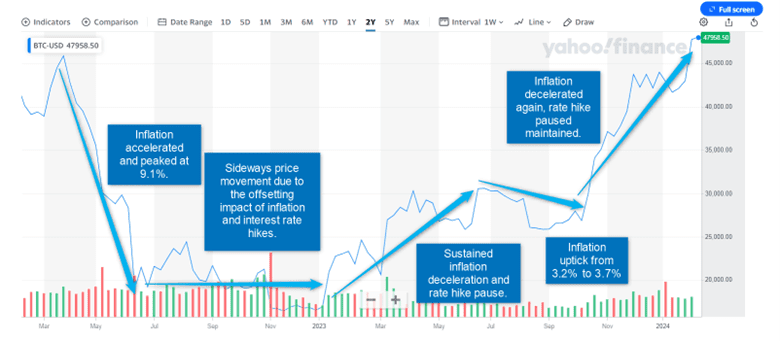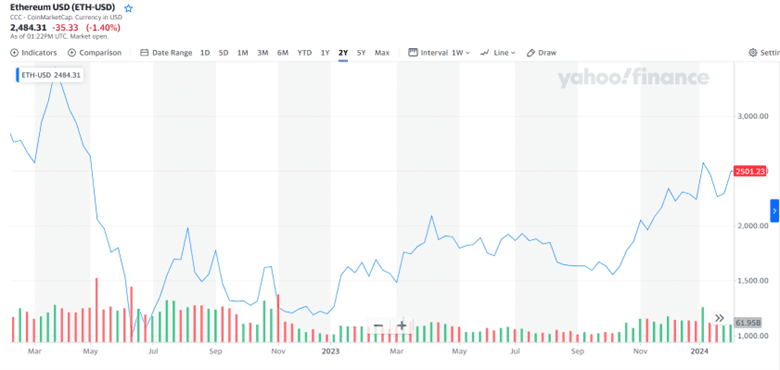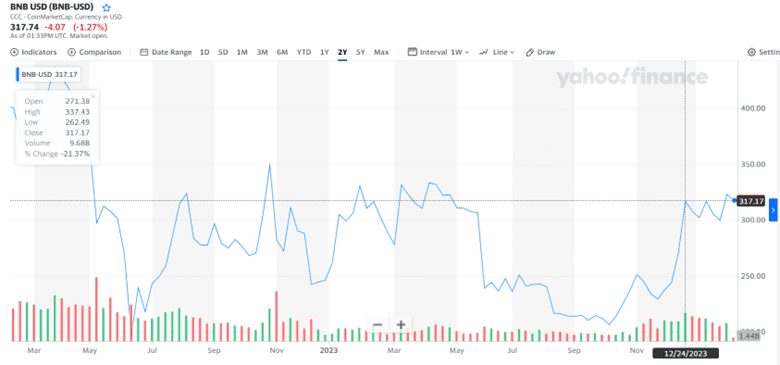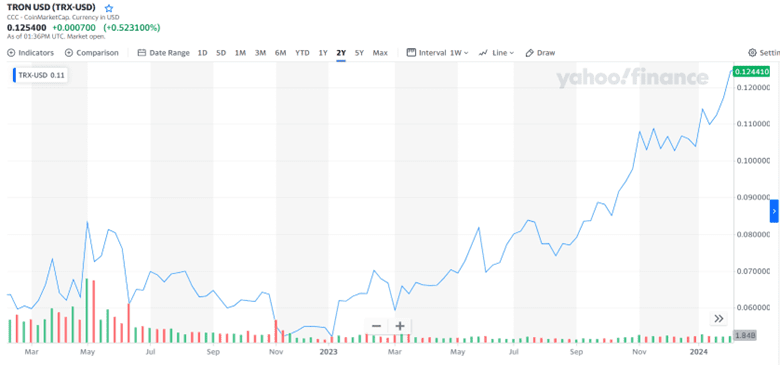The global economy has been through a series of sharp crests and troughs in the past four years. It was most evident in the capital market as macroeconomic changes affected investor sentiments. In turn, various assets have become more volatile. Yet, some investments, such as cryptocurrencies and forex, drew more attention from investors.
Capitalizing on price dips was one of the primary investment strategies, hoping the value would rebound in the long run. Finding an excellent investment to optimize risks and returns was another goal.
But identifying the best inflation hedge amid the still elevated prices and interest rates was the ultimate target as recession woes resurfaced. In the past year, primary macroeconomic indicators improved, but investors wanted to ensure minimal risks with competitive returns.
At this point, analysts and policymakers are more optimistic about the macroeconomic conditions this year. This makes various investments more enticing today, given their potential growth prospects. Inflation decelerations, interest rate cuts, and higher purchasing power are some forces to drive their growth. Unsurprisingly, cryptocurrencies and forex are soaring in value and volume as their demand rises.
Given this, many investors weigh the advantages and disadvantages of holding fiat and digital currencies. Both have high volatility, risks, and returns but are somewhat different. As such, it is essential to consider factors such as risk tolerance and market knowledge to understand them better.
Hence, this article will delve into the cryptocurrency and forex market and help you find the right investment for you this FY24.
Crypto Basics
Cryptocurrencies are digital assets or currencies that use advanced coding and encryption, known as cryptography, to secure transactions.
In contrast to traditional fiat currencies, cryptocurrencies are decentralized and unregulated by the government. Instead, these are built, run, and tracked on a systematic technology called blockchain, a ledger that records all crypto transactions. With that, the market ensures transparency while maintaining security and anonymity.
Over the past decade, the crypto market has gained popularity, led by the inception of Bitcoin (BTC). Since then, various cryptocurrencies have entered the market. Even so, most have minimal market capitalization, giving them limited impact on crypto trading. Some prominent cryptos aside from BTC include Ethereum (ETH), Dogecoin (DOGE), Binance (BNB), and Cardano (ADA).
Currently, it has a global trading volume of $45.74B with a total market capitalization of $$1.8T.
Forex Basics
The Foreign Exchange Market, or simply FX or Forex, is the largest and most liquid type of financial market in the world.
Forex allows investors to trade one fiat currency for another, aiming to profit from exchange rate differences and fluctuations. Major currency pairs, such as USD/GBP, USD/JPY, and USD/EUR, are some popular options for traders. Other traders prefer minor and exotic currency pairs, such as USD/AUD, GBP/AUD, USD/THB, and GBP/MYR. These are often riskier but can generate higher returns.
Like the cryptocurrency market, forex is known for its high level of volatility and liquidity. Although the government regulates it, security and anonymity are also present in the market.
Currently, it has an average global trading volume of over $6T per day.
Key Differences
These are the differences to consider before entering the crypto and forex markets.
| Comparison of Crypto and Forex | ||
| Cryptocurrency | Forex | |
| Market Hours | The crypto market is the most accessible financial market globally.
It is open 24 hours every day, even during weekends and holidays. This flexibility makes trading possible at a convenient time for investors. Yet, one must stay tuned to news and current events, even during weekends and holidays. These can affect market sentiments and crypto prices instantaneously. |
The Forex market is less accessible than the crypto market but more accessible than the stock market.
It is open 24 hours, five days a week. Forex trading is divided into Sydney, Tokyo, London, and New York sessions. These are the four significant sessions with overlapping hours to ensure continuous trading. This pattern allows traders to make and change their buying and selling positions in real-time, given its high volatility and sensitivity to news and political and economic events globally. |
| Investment Types | Cryptocurrencies are digital coins, assets, currencies, or tokens. These include thousands of coins, but the most popular and largest ones in market capitalization and volume are BTC, ETH, ADA, DOGE, and BNB. | Forex investments are fiat currencies representing their respective economies: USD for the US, EUR for the EU, GBP for the UK, JPY for Japan, and AUD for Australia. |
| Market Participants | There is a wide range of participants, from retail and individual traders to institutional investors, businesses, crypto miners, and blockchain developers. | Forex also has a diverse group but concentrates on large groups and financial institutions. These include retail traders, financial institutions, multinational corporations, banks, governments, and central banks. |
| Trading Platforms | Crypto trading takes place on crypto exchanges, such as Binance, Kraken, Coinbase, KuCoin, and Bitfinex. Crypto traders can buy and sell various digital coins on these exchanges. | Forex trading takes place through brokers’ platforms like FXTM. Trading is done by buying and selling currencies in exchange for another. Also, price speculations can be done using derivatives, such as contracts and options, without buying their underlying assets. |
| Influence | Crypto prices are heavily impacted by market sentiments from news and current events.
But in the past three years, prices have become more sensitive to macroeconomic changes, particularly inflation. We will make a separate discussion on inflation and crypto prices. |
Forex prices are heavily impacted by the macroeconomic conditions of currency pairs. The primary indicators are their respective inflation, interest rates, and Balance of Payments (BoP). Government borrowings and political disturbances can also affect them.
Given these, the market may require familiarity with economic theories and factors affecting currencies. Watching forex trading tutorials and reading forex eBooks will help beginners grasp the market. |
| Regulations | The crypto market is decentralized and unregulated.
But cryptocurrencies are managed, tracked, and run on blockchain technology. It serves as a ledger to record all crypto transactions across various devices. |
Governments regulate forex trading. |
| Volatility | The cryptocurrency market is notorious for its high level of volatility. Prices can make sharp highs and dips in a matter of minutes. This aspect is a double-edged sword that carries trading opportunities and risks.
But in the past three years, prices have appeared to be more predictable. Their inverse correlation with inflation should be noted. We will thoroughly discuss this in the succeeding parts. |
Forex is a highly volatile market relative to stocks and bonds but less volatile than crypto.
Currency pairs can have gradual price movements. But massive fluctuations must not be discarded. These can happen, often driven by economic changes, banking decisions, and geopolitical events. An example is the Swiss Franc Shock in 2015, which put a lot of brokers and traders into the gutter. For a long time, the Swiss Franc was pegged at 1.20. But when the Swiss National Bank abandoned this, the currency appreciated by 41% against the Euro on the same day. This led to losses of about $100 million. It depleted the capital of three forex brokers and even sent FXCM to the brink of bankruptcy. |
| Liquidity | The crypto market has thrived and expanded over the past decade. It currently has a global trading volume of over $40B with a market capitalization of nearly $2T. Even so, it is still much lower than the forex market.
Liquidity varies among various cryptocurrencies. It is high in primary coins, such as BTC, BNB, and ETH. However, it is typically low in new and less popular cryptocurrencies. Executing large buy and sell orders in these cryptocurrencies can be difficult and time-consuming. Hence, the value bought and sold may increase or decrease since these have already been affected by various market forces. |
The forex market is the most liquid type of financial market, with a global average trading volume of $6T per day.
Its exceptionally high liquidity allows traders to enter and exit their positions swiftly. The considerable number of market participants ensures continued trading. As such, traders can execute their entry and exit orders without high price slippages. |
Can cryptocurrencies and forex become inflation hedges?
Amid the still challenging economic environment, the capital market sees sprinkles of hope as inflation deceleration continues. Despite the slight uptick in the last report, the 3.4% inflation rate stays near the Fed’s 2%-3% target band. Also, it was primarily driven by the substantial increase in consumption during the holiday season.
Even so, we saw the uptrend of stock and crypto prices slow down for a few days after the inflation report. The same goes for Forex trading, which is highly reactive to inflationary headwinds. With that, it is essential to determine whether cryptocurrencies and forex can become ideal inflation hedges.
Cryptocurrencies
For many years, cryptocurrency price changes have been seen to have been driven purely by market sentiments. News and geopolitical events were some factors affecting their prices. That is why the crypto market has been notorious for being volatile.
Yet, the past three years showed the increasing predictability of price trends. It will be more evident if we trace it to inflationary changes.
In the picture below, we can see the inverse relationship between inflation and BTC price movements.
Bitcoin (BTC)
Image Source: Yahoo Finance
The same pattern can be observed in other cryptocurrencies, such as ETH, BNB, and TRON. They also showed high sensitivity to inflation as they increased amid the inflation acceleration. Their direction changed when inflation decelerated, matched with the interest rate hike pause.
Ethereum (ETH)
Image Source: Yahoo Finance
Binance (BNB)
Image Source: Yahoo Finance
Tron (TRX)
Image Source: Yahoo Finance
Cardano (ADA)
Image Source: Yahoo Finance
To further prove our point, we measured the degree of their relationship since 2017 using the correlation analysis on MS Excel.
Inflation and BTC- 62% Inverse Correlation or Strong Correlation
Inflation and ETH- 70% Inverse Correlation or Strong Correlation
Inflation and BNB- 72% Inverse Correlation or Strong Correlation
Inflation and TRX- 53% Inverse Correlation or Moderately Strong Correlation
Inflation and ADA- 42% Inverse Correlation or Moderate Correlation
Given all the data, we can say that cryptocurrency prices, mainly BTC, ETH, and BNB, are heavily affected by inflation. When inflation skyrocketed, their prices had a steep fall. Conversely, their prices rebounded when inflation decelerated.
Despite this, the results are still impressive if we check the whole price trend. Their actual returns since 2017 have been very high. There may have been sharp plunges, but overall, their seven-year returns were much higher than the S&P 500 (SPX) and NASDAQ Composite (IXIC). The table below compares the risks and returns of cryptocurrencies and stock indices.
| BTC | ETH | BNB | TRX | ADA | Average | SPX | IXIC | |
| Seven-
Year Returns |
4,255% | 201% | 3,518% | 141% | 50% | 2041% | 78% | 117% |
| Average Annual Returns | 146.27% | 48.48% | 99.81% | 83.48% | 4.9% | 76.98% | 12.12% | 16.08% |
| St. Dev. | 76.79% | 88.46% | 174.34% | 113.76% | 117.25% | 114.12% | 17.71% | 20.91% |
| Sharpe Ratio | 1.84 | 0.50 | 0.56 | 0.70 | 0.08 | 0.72 | 0.45 | 0.58 |
Given all these, primary cryptocurrencies outperformed the primary stock indices. Their volatility may be about five to ten times of SPX and IXIC. Yet, their returns outweighed the risks. These can show that cryptocurrencies have been an effective inflation hedge over the years.
Forex
Forex is also highly volatile and reactive to macroeconomic changes. Yet, avoiding or hedging inflation is easy by choosing the correct currency.
Amid the global economic recovery, traders must look for the fastest-recovering economy. But they must compare their respective inflation, interest rates, and net exports. These macroeconomic indicators have a considerable effect on the currency value.
They must also watch out for any geopolitical disturbances. Currently, Ukraine, Russia, Israel, and Palestine are some countries with ongoing wars. But it is also essential to observe other countries’ war contributions or participation since these may also affect their economy.
Outlook
Here’s what we can expect in the crypto and forex market in FY24.
Cryptocurrency
From the previous section, we saw a strong correlation between inflation and cryptocurrency prices.
Given the current trend of inflation, we can expect the price rally to persist this year. This may speed up as the Fed expects to cut interest rates three times this FY. With that, investors may take advantage of price dips and pullbacks to take a buy position. It may be a profitable year for traders, especially those who took advantage of the market lows in the past two years.
Moreover, the US Sec approved 11 spot BTC Exchange-Traded Funds (ETFs) on January 10, 2024. This approval will allow investors to buy exposure to BTC on any US stock market. They can watch their investment thrive or shrink when BTC increases or decreases.
This will increase the demand for Bitcoins by the funds holding these spot ETFs. We must note that US households have nearly $18T in liquid assets, primarily cash on hand and cash deposits, from $10T in 2013. So, Americans are capable of buying more investments, including digital assets. In turn, the BTC price increase may persist.
Altcoins may expect the same trend since BTC also affects their demand. If the Bitcoin price increase exceeds traders’ buying power, they can look for cheaper alternatives. This will give positive spillovers to other coins, such as ETH, BNB, TRX, and ADA. Also, ETH may continue to lead blockchain technology innovations in FY24 with its updated roadmap.
Forex
Lower inflation and lower interest rates may increase the investing power in the market. There may be more capital inflows in the financial market. The value of the US Dollar may increase as the global economy recovers.
However, it may vary with the economic conditions of its pairs, such as GBP, AUD, EUR, and JPY. It may be easier to track various currencies as macroeconomic conditions become more manageable. Speculations of currency pair changes may become more precise as consumption, borrowings, and investing normalize.
Which is better for you?
Doing technical analysis can be very challenging in the crypto market. But given its evident correlation with inflation and potential growth drivers, the market may be friendlier today, especially to newbies.
Meanwhile, the forex market is easier to predict but requires more skills and knowledge in macroeconomics. Also, it entails traders watching two currencies and economies at the same time.













































